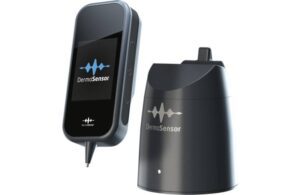
DermaSensor announced clinical data validating its handheld, non-invasive device for assisting in the detection of skin cancer.
In collaboration with Mayo Clinic and the University of Connecticut School of Medicine, the company presented two studies. One demonstrated the standalone performance of DermaSensor’s novel elastic scattering spectroscopy (ESS) device. The other evaluated the impact of the device on primary care physicians’ (PCP) management of skin cancer.
DermaSensor previously announced positive data supporting its technology in March.
Miami, Florida-based DermaSensor’s handheld device uses ESS, a form of optical spectroscopy. It takes noninvasive samples of tissue, capturing cellular-level information. The technology uses hundreds of wavelengths of light in a manner similar to how sonar uses sound.
“These two pivotal studies, which are two of four studies currently under review by FDA, have shown that our FDA Breakthrough device significantly improves skin cancer detection by primary care physicians,” said Cody Simmons, DermaSensor CEO. “The results of both studies provide clear evidence that our ESS device is a valuable tool in point-of-care skin lesion evaluation with the ability to aid PCPs in identifying skin cancer for referral.”
About the DermaSensor data
DermaSensor’s clinical validation study enrolled 1,005 patients across 22 primary care centers, evaluating 1,579 lesions in total. Dermatopathology evaluation confirmed 224 high-risk lesions, including melanomas, basal cell carcinomas, and squamous cell carcinomas.
The ESS device achieved device sensitivity (95.5%) superior to that of the PCPs (83%).
A total of 108 PCPs conducted DermaSensor’s companion clinical utility reader study. The study successfully demonstrated that PCP use of the device improved their detection of skin cancer. When unaided by the device, PCPs only correctly referred 82% of cancerous lesions. However, when equipped with the device, they correctly referred 91.4% of skin cancers.
Additionally, physicians did not refer 18% of skin cancers with their standard of care alone. They halved that metric to 8.6% when using the device. The study demonstrated an increase in physician referrals of benign lesions when aided by the device result.
“As skin cancer rates continue to rise, the need for accurate and efficient skin cancer detection in primary care is increasingly important. These studies have shown the ESS device benefits physicians, and it is also a non-invasive, easy-to-use solution for instantaneously evaluating suspicious lesions,” said Dr. Daniel Siegel, a clinical professor of dermatology at SUNY Downstate and the principal investigator for the clinical utility study. “Effective tools for skin cancer detection and management could lead to earlier diagnosis, better outcomes, and reduced healthcare costs for patients and the healthcare system as a whole.”
Siegel also serves those who served at the Brooklyn VA and is a former President of the American Academy of Dermatology.